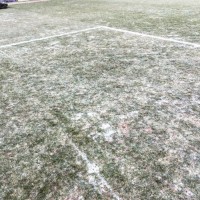
If you need any assistance, try the Pitchcare Forum, where you will find advice, information and support from other groundsmen.
Key Tasks for February

These mild temperatures between the cold spells will promote fungal disease. Use approved fungicides to treat any infected areas.
Leaf spot can be quite damaging, especially in stadium environments; keep the leaf blade relatively dry by regular brushing, and apply an approved fungicide to prevent further outbreaks
Red thread can develop at any time during cool, wet weather. It can develop on most turfgrasses, but ryegrasses, meadow grasses and fescues appear to be more commonly affected.
This disease is often referred to as an indicator of low fertility, and symptoms will often develop more severely if nitrogen or potassium is limited.
Usually a dose of fertiliser will help control an outbreak of red thread.
Always ensure that the disease is correctly identified prior to applying any plant protection product.
Maintain a height of cut between 24-30mm.
General maintenance:
- Continue cutting to encourage good sward density, ensuring that you do not over cut as this would thin out the sward due to the slowdown in growth
- Ensure that any equipment used is keenly set to cut
- Regular brushing will keep the air circulating around the base of the plant
- Deep spike to alleviate compaction when conditions allow
- Keep your spiking regime flexible, alternating between surface spiking, deep spiking and slitting
- Hand fork goalmouth and centre circle areas, if difficult to get onto the pitch with machinery
- Use any downtime to overhaul/service machinery
- In the unlikely event of frost this January, keep off the pitch until it has lifted or it becomes absolutely necessary. This will avoid damage to the grass plant/leaf
Try to keep the top 100mm free draining; this can be achieved by regular spiking with solid or slit tines to a depth of 150mm or more.
Marking out
- Keep your linemarker clean
- Keep string lines taut
- Ensure that right angles are correctly formed. Use the 3:4:5 triangle method. The bigger the triangle at the start, the more accurate the pitch will be.
Pre and post match routines
Before the match
- Check that the pitch is fit and safe for play
- Check for debris (glass, stones etc.)
- Clear away leaves – a thankless task, but one that needs doing
- Ensure the surface is firm and not saturated, correctly marked out and flagged, and that the posts are safe and secure
Post match
- Replace divots, even if it’s just the worst affected areas - it will make a difference!
- Dragmat/brush/harrow to restore playing surfaces and remove worm casts
- Clean up the playing surface with a rotary mower
Additionally ...
- February and March provide the opportunity to plan ahead for end of season renovations; particularly important if you have been affected by flooding
- You could also consider booking in your machinery for its annual service/repair, ensuring you get the time slot that suits you
- Dragmat, harrow and groom rake surface, as required, to maintain levels, remove early morning dew, control disease and generally get air in and around the plant
- Spike/verticut as often as possible
Remember – the more that club members, players and officials understand what you role involves, the better. You could use any spare time to provide a members newsletter/blog detailing what problems you are experiencing (training regimes, waterlogging etc.) and to seek additional help as required.




As daytime temperatures potentially begin to warm, it is important to nurse the plant through the end of winter with a gentle amount of NPK fertiliser, either as little and often foliar applications or with a conventional release mineral fertiliser. The aim should be to keep the plant healthy, not to force growth, as excess nutrition will either go to waste when cold or force the plant on too much when warmer, in turn making soft young growth susceptible to damage from the harsh winds and temperatures during cold snaps and fungal attack in warm, damp, still periods.
Sulphur is an important nutrient when it comes to assisting plant metabolic function early in the season. So, planning now to apply a feed in March, which contains a high percentage of this vital element, should be considered.
Towards the end of the month, the sun may begin to feel noticeably warm in sheltered areas, but turf managers should be mindful that it is soil temperatures which drive growth with night time temperatures the biggest contributing factor to average soil temperatures throughout the day.
Put simply:
warm day and warm night = warming soil temperatures
warm day and cold night = stable soil temperatures
It is important to try and continue the protection of winter sports pitches from play when surfaces are wet. A notable reduction in plant surface density at this point will dramatically reduce the sward's ability to kick on in the spring, resulting in prolonged periods of reduced playing quality at the end of the season and corresponding increases in resources required for end of season renovations.
February represents a good time to undertake PWS testing on your surfaces. A cost effective broad spectrum soil analysis is available from the Pitchcare shop, with the subsequent report giving you a tangible point of reference as to what the soil requires when it comes to planning your spring and summer fertiliser applications.
Implementing an integrated turf management approach to managing disease is the responsible way to approach this issue, reducing periods of extended leaf blade wetness to a minimum by either removing dews by brushing or switching. Dew dispersal products offer a solution for this situation on club facilities where daily removal by hand is more difficult.
Keeping an eye on weather forecasts, and applying fungicides in good time when weather conditions are predicted to be the most conducive for disease development, is the best way to minimise damage. Once obvious damage is evident, applications are entering into a curative phase. The most effective and responsible approach is to aim for a preventative or early curative regime whereby diseases, and in particular microdochium patch, are treated prior to, or at the earliest signs of infection.
Aeration, as always, continues to be of utmost importance and should be undertaken whenever conditions allow good recovery and the risk of damaging wet soils is at a minimum.
If moisture and warmth coincide towards the end of the month, then it is an opportunity to seed any remaining small bare patches which might have lingered over winter, although germination will be slow especially if colder weather then intervenes.

With pests such as rabbits, foxes and moles it a case of identifying the problem and controlling their activities; employing approved pest control services to eradicate them from site may be a solution.
Brushing or switching of the playing surface keeps the green clean and removes any dew or surface water. Keeping the surface dry will aid resistance to disease.
The typical types of diseases you may come across are:
- Fusarium Patch
- Red Thread
- Fairy Rings
- Anthracnose
Use appropriate fungicides to control any further outbreaks, however, with the grass soon beginning to grow, it won't take long for these scars to grow out.
More information on these and many others can be found here: https://www.pitchcare.com/useful/diseases.php
- Keep your machinery in tip top condition
- Grease where you find a grease nipple, oil where you see a metallic moving part, check the oil, check the water
- Clean it when you've finished

Delegates attending the Winter Sports Pitch Maintenance course and using the accompanying manual will be able to develop their own skills, working knowledge and expertise, by understanding the method of instruction and the maintenance principles it sets out.
Details of our forthcoming autumn courses can be found on our new website Grounds Training
Included in the Course Manual, there are working diaries showing the range of tasks needed to be accomplished each month. The Course Manual is available for purchase separately.
In addition, we are able to arrange courses to be delivered on site to groups of 6 – 10 people. Email Chris Johnson for information.
Weekly checks:
- Check goals for loose bolts and tighten as necessary
- Check nets - make sure they are properly supported at the back of the goal and aren't sagging
- Check team dugouts are stable and anchored securely. Make sure that they are tidy and free from litter
- Repair and maintain fence lines
- Sweep up/vacuum fallen leaves
Articles you may find helpful
https://www.pitchcare.com/magazine/managing-moss.html
https://www.pitchcare.com/magazine/a-world-without-oxygen.html
https://www.pitchcare.com/magazine/winter-sports-pitches.html
https://www.pitchcare.com/magazine/winter-games-pitches-preparing-for-repairing.html


